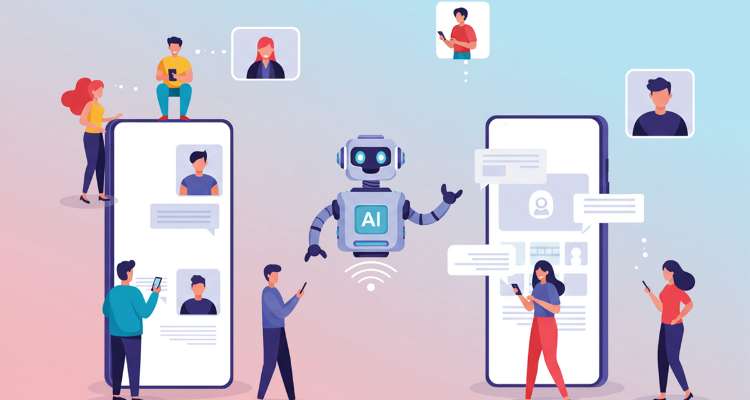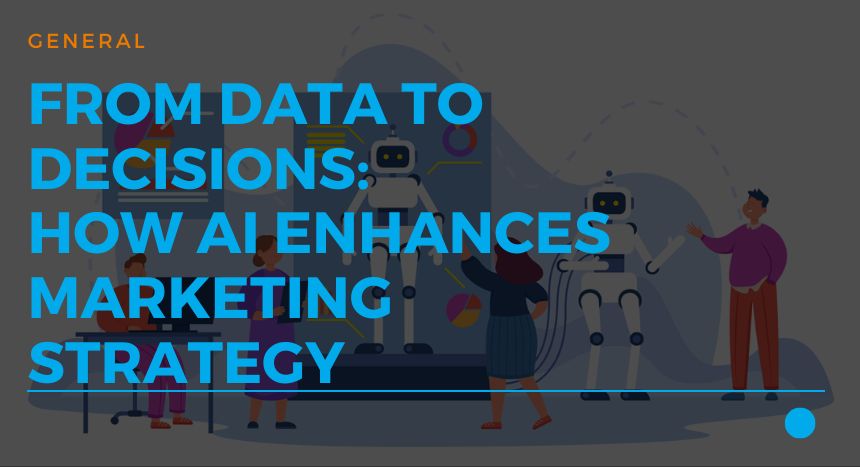- The Age of Data-Driven Marketing
- AI: The Marketer’s New Partner in Crime
- Personalization: The Real Game Changer
- Predictive Analytics: Guessing the Future (and Being Right)
- AI and the Art of Content Creation
- Building Better Customer Experiences
- Smarter Ads, Sharper Spending
- Seeing Beyond Words: The Rise of Visual AI
- Voice and Conversational Marketing
- Social Media Insights: Where AI Listens
- AI in Email Marketing: Smart and Subtle
- Data Privacy and Ethics: Walking the Thin Line
- Challenges: When AI Isn’t Perfect
- Future: Smarter, Faster, Deeper
- Human Element: Still the Heart of It All
- Conclusion
- Inam Ullah Dar
Can machines really think like marketers? Ever watched a marketer drown in numbers? Clicks. Likes. Reach. Conversions. All stacked like an ocean of data. You can almost see the confusion on their face. So any numbers, but what do they mean?
That’s where AI walks in. Cool. Calm. Fast. Like a digital brain, it scans everything: patterns, trends, moods. It doesn’t just collect info. It learns. Predicts. Suggests.
Marketing used to be about gut feelings. Now it’s about algorithms with feelings. Well, almost. AI doesn’t just make data easy. It turns it into stories, stories about customers, desires, and timing. It helps brands act smarter, not harder. And suddenly, marketing isn’t guessing anymore. It’s knowing.
The Age of Data-Driven Marketing
Gone are the days when intuition ruled. Data rules now. Cold, endless, detailed data. Every scroll, every tap, every tiny online move, it’s all tracked.
Marketers once trusted their instincts. Now, they trust AI models that read millions of data points in seconds. Creepy? A little. But effective? Definitely.
AI digs deep into patterns humans might miss. It sees when customers start losing interest or when they’re about to click “buy.” It whispers, “Target that one. She’s ready.”
That’s power. Data-backed power. And it’s changing how every business operates, from local cafés to global brands.

AI: The Marketer’s New Partner in Crime
Think of AI as that quiet coworker who never complains—always analyzing and always working.
It doesn’t steal your job; it makes it easier. AI tools like Google’s Smart Campaigns or HubSpot’s predictive analytics are like personal assistants with superpowers. They handle the boring stuff: sorting, comparing, testing. You get to do the fun part, creating stories, building emotion.
AI isn’t here to replace humans. It’s here to enhance them. Humans bring the heart. AI brings the brain. Together, they make marketing magic.

Personalization: The Real Game Changer
Ever had that creepy moment when an ad seems to read your mind? Like you talk about sneakers, and Nike ads appear? Yeah. That’s AI personalization doing its thing.
It studies your patterns, what you look at, what you ignore, and even how long you hover on a picture. Then it predicts what you’ll like next.
Personalization used to mean “Hi, [Name]” in an email. Not anymore. AI now builds entire experiences around you. The layout, the timing, the product suggestions, all crafted by machine logic that somehow feels human. It’s spooky smart. But it works. Because when customers feel seen, they buy.

Predictive Analytics: Guessing the Future (and Being Right)
Imagine if you could predict who’ll buy from you next week. Or who’s about to stop visiting your site? That’s not fantasy anymore. That’s predictive analytics. AI looks at past data purchases, clicks, abandoned carts and creates a model. Then it forecasts what’s next.
It’s like weather prediction, but for human behavior. Marketers use this to send offers before customers even realize they want something.
Predictive analytics saves money, time, and energy. It tells you where to focus, who to chase, and when to strike. And when you listen, sales climb.

AI and the Art of Content Creation
You’ve probably read something written by AI and didn’t even know. Articles. Captions. Product descriptions. AI tools like Jasper and ChatGPT write faster than any human.
But writing’s just one part. AI also checks what works. It measures engagement, click rates, bounce time, and even how long someone stares at an image. Then it adjusts the tone, structure, and keywords.
So, while humans bring the flair, AI brings the facts. It tells you, “This works. That doesn’t. Try again.” Marketers no longer shoot in the dark. They know what connects before they even hit publish.

Building Better Customer Experiences
Picture this. You visit a website. Within seconds, a chatbot pops up—friendly, fast, maybe even funny. “Need help?” it asks. You type. It replies instantly—no hold music. No waiting.
That’s AI in customer experience: chatbots, virtual assistants, and recommendation systems are all powered by learning algorithms that remember your last move.
AI doesn’t just respond. It understands tone. Frustration. Urgency. It knows when to apologize and when to upsell. And customers? They love it. They feel heard. Valued. Understood. That’s not customer service anymore. That’s the connection.

Smarter Ads, Sharper Spending
There was a time when ads were pure guesswork. Place them anywhere. Hope someone bites. Waste a few dollars. AI fixed that.
Now, algorithms choose when and where to show an ad. They study audience data, locations, and even the time of day people are most likely to click. They adjust bids automatically. Every penny counts.
Platforms like Facebook Ads, Google Performance Max, and TikTok Ads all run on machine learning. They optimize, experiment, and improve in real time. The result? Less waste. More conversions. Smarter decisions. It’s like hiring a strategist who never sleeps.

Seeing Beyond Words: The Rise of Visual AI
AI doesn’t just read, it sees. Through image recognition, it spots objects, logos, colors, and even facial expressions. Brands use this to know which visuals catch eyes if customers stop scrolling at a red product more often, AI notices. Next campaign? More red.
Visual AI helps e-commerce stores pick better thumbnails, highlight trending products, and design more attractive layouts. Even small businesses can benefit from using WooCommerce Product Badges to tag “Best Seller,” “AI Recommended,” or “Trending.” It’s a small touch that gets big clicks. AI understands what images speak louder than words.

Voice and Conversational Marketing
People talk more than they type. That’s why voice search exploded.
“Alexa, find me a coffee shop.”
“Hey Google, show me running shoes.”
AI gets this. It understands accents, slang, and emotion. For marketers, that means optimizing content for how people speak, not just how they type.
Conversational AI also powers customer chats. It guides users, makes jokes, and even remembers preferences. Each chat makes it smarter. The future of marketing? It’s not typed. It’s spoken.

Social Media Insights: Where AI Listens
Social media is chaos. Billions of posts. Millions of opinions. How can anyone keep up? AI can. It listens to online conversations. Detects trends. Tracks mentions. Spots brand sentiment whether people love or hate you instantly.
AI tools like Sprout Social and Brandwatch dig deep into audience moods. They tell you which hashtags work, when to post, and which influencers are real (and which ones are fake). Suddenly, marketing on social media isn’t guesswork anymore. It’s science. And it’s fast.

AI in Email Marketing: Smart and Subtle
Emails used to feel like shouting into the void. “Buy this!” “Click here!” Now, AI makes them smarter. It checks what subject lines get opened, what links get ignored, and what times readers actually click. Then it adjusts automatically.
AI even writes the perfect subject line for each segment. Curious readers get questions. Impulsive ones get offers. Loyal ones get appreciation—no more mass blasts. Every email feels personal. Like it was written just for you, and that’s why it works.

Data Privacy and Ethics: Walking the Thin Line
AI loves data. But that’s where trouble begins. The more data it uses, the more questions arise: Who owns it? Who controls it? Who protects it? Customers are smarter now. They ask questions. They demand transparency. And they should.
Marketers need to be honest. Tell users what you collect, and why you need it. How does it help them? Because trust is everything, regulations like GDPR and CCPA are not roadblocks; they’re reminders. AI should serve people, not spy on them. Ethical AI marketing isn’t just right. It’s smart business.

Challenges: When AI Isn’t Perfect
Let’s be real. AI isn’t flawless. It messes up sometimes. Bad data leads to bad predictions. Biased data leads to unfair outcomes. And over-reliance on machines? That kills creativity.
Marketers can’t just let algorithms take over completely. They need balance logic from AI, emotion from humans.
Another hurdle: learning curve. Many teams don’t know how to use these tools fully. Without training, AI becomes just another expensive toy. So yes, it’s powerful. But it’s not magic. It needs the right hands to work well.

Future: Smarter, Faster, Deeper
The road ahead looks wild. Soon, AI will do more than predict. It’ll create entire marketing campaigns automatically. Tailor visuals in real time. Even measure emotional reactions through sensors or wearables.
AR and AI together will reshape online shopping. Imagine pointing your phone and seeing how that jacket fits. AI adjusts the lighting, size, and color for your body.
Marketers won’t just track behavior, they’ll anticipate it. The line between human intuition and machine learning will blur even more. And marketing? It’ll become hyper-personal, almost instinctive.

Human Element: Still the Heart of It All
For all its brilliance, AI can’t feel. It doesn’t dream. It doesn’t care. Humans do.
Emotion drives connection. Stories move people. AI might suggest the words, but humans give them meaning. That’s what great marketing still needs: heart.
Think of it like a duet. AI provides rhythm, data, and structure. Humans bring melody, empathy, and flair. Together, they make something unforgettable. AI enhances creativity. It doesn’t erase it.

Conclusion
AI isn’t some fancy buzzword anymore. It’s the backbone of modern marketing. It turns chaos into clarity. Data in the direction. Decisions for growth. The marketers who embrace it? They lead. They adapt. They win.
AI analyzes trends. Writes content. Predicts behaviors. Delivers personalization like never before. But it’s the human behind the screen who gives it purpose. This partnership between machine and mind defines the future. The smarter we use it, the more powerful our stories become.
From every click to every conversion, AI whispers insights that shape destiny. It’s not about replacing us. It’s about upgrading what we can do. From data to decisions. From confusion to clarity. From marketing to magic.

Inam Ullah Dar
Motif CreativesInam Ullah Dar is a content writer by passion and profession. He started his journey with Motif Creatives. He primarily writes for guest post articles falling under various niches. The main area of his interest and expertise is Web design & Digital marketing. He enjoys reading and writing about healthcare, mindfulness, and well-being to educate people about being happier and lively. His work has been published on many high-authority websites. He believes that writing is an effective way to communicate at better levels.

